DMM UNI-T UT33D+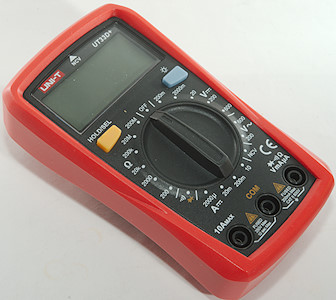
This is a fairly simple DMM with manual ranges and a minimum of functions.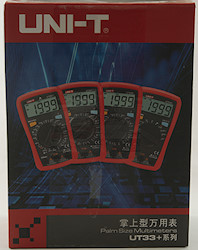
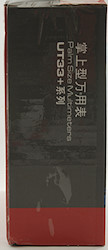
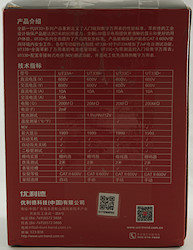
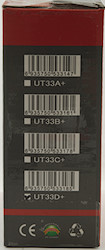
The box is for all the UT33 meters with a checkmark for the actual model and a table on the back for comparing the models (in Chinese).
If you want all the function, you must buy all the models, none of them can everything.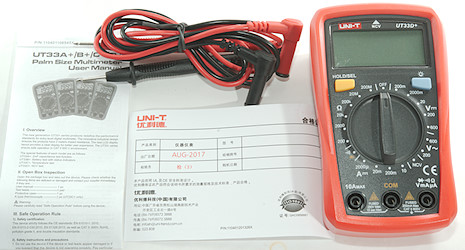
In the box was the meter, probe leads and a instruction sheet. The instruction sheet is for all four models in the series (A, B, C, D).

The standard probes are about normal size, but rating them for 10A is on the optimistic side.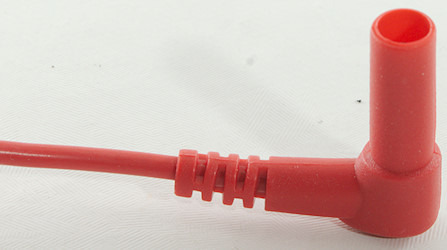
The plugs are fully shrouded.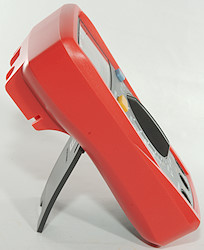
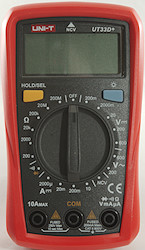
With the meter lying flat it is possible to turn the switch, but on the tilting bale it will slide around.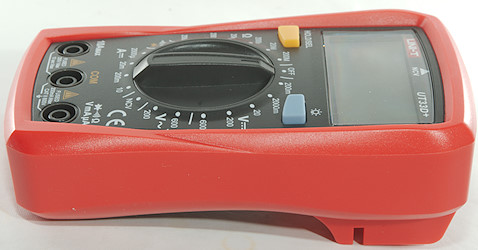

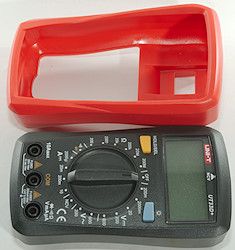
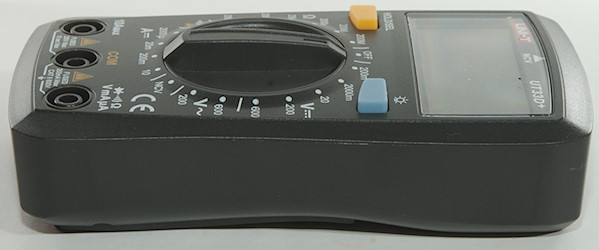

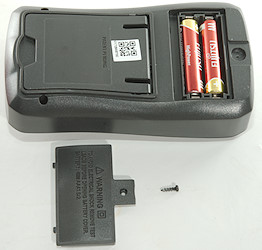
Display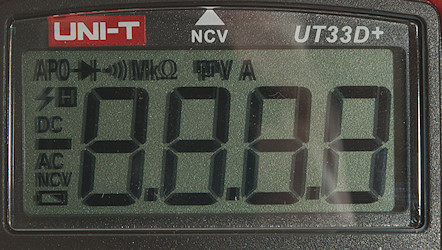
All the segments are shown during power on.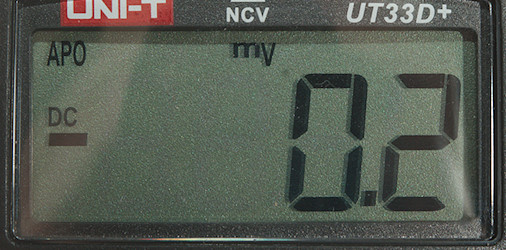
Typical display during usage, it will show the number and selected measurement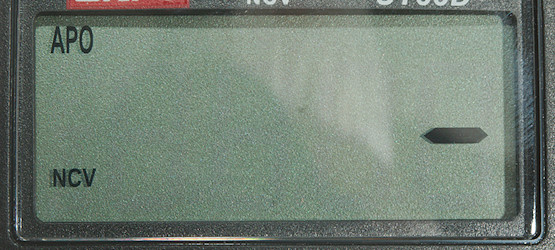
The NCV detector will show bars depending on field strength and the buzzer will sound when anything is detected.
Functions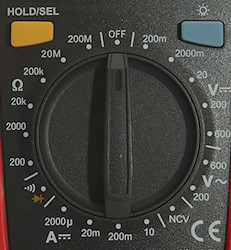
Buttons:
- Hold/sel: Will freeze the display reading, until pressed again. In diode/continuity it will select between diode and continuity.
- Backlight: Turn backlight on, press again to turn off.
Rotary switch:
- Off: Meter is turned off
- VDC: 200m, 2, 20, 200, 600: DC voltage range.
- VAC: 600 & 200: AC voltage ranges.
- NCV: Non-contact voltage or electric field detection.
- ADC: 10A, 200m, 20m 2000u: DC current range
![rangeDiode]() : Continuity and diode.
: Continuity and diode.- Ohm: 200, 2000, 20k, 200k, 20M, 200M
Input
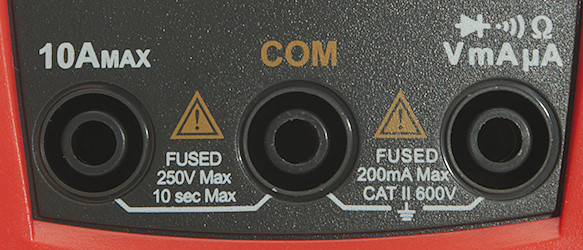
- 10ADC: 10A DC current input.
- COM: The common terminal for all ranges.
- xxx: All other ranges, including mA. It is always problematic when a current range shares connector with a voltage range, if the switch is in the wrong position the fuse will blow (at least). This will only affect current, voltage will still work.
Measurements
- Volt and frequency
- 5V AC readings is 5% down at 3kHz
- Input impedance is 10-11Mohm on DC
- Input impedance is 10Mohm on AC.
- Input protection is 600V AC/DC
- 5V AC readings is 5% down at 3kHz
- Current
- 10A range is fused with a 10A/250V fuse
- mA range is fused with a 0.2A/250V fuse
- 10A range has an audible alarm at 10A or above.
- 10A range is fused with a 10A/250V fuse
- Ohm, continuity, diode and capacity
- Ohm voltage is 1V open.
- Ohm current is 270uA in 200/2000ohm, 75uA in 20k, 9uA in 200k, 0.9uA in 20M and 200M
- Continuity is fast (About 20ms).
- Continuity beeps when resistance is below 31ohm.
- Continuity is 2.1V open and 0.27mA shorted
- Diode range uses 2.2V, max. display is 1.999V at 0.08mA, max. current is 0.9mA shorted
- Overload protection is 600V AC/DC
- Ohm voltage is 1V open.
- Miscellaneous
- Current consumption of meter is 1 to 1.2mA (15mA with backlight).
- Display gets unstable about 1.6V, but it might show overflow before, battery symbol show at 2.3V.
- Readings will be correct down to 2.4V, below that they can be high or display can show OL
- Backlight works down to 1.6V
- Viewing angle is good
- Display updates around 2.5 times/sec
- Backlight will turn off in about 30 seconds.
- Will automatic turn power off in about 15 minutes.
- Standard probes fits in the meter.
- The meter usual need a couple of display update to reach the final value.
- Weight is 211g without accessories, but with sleeve and batteries.
- Size is 135 × 77 × 47mm
- Current consumption of meter is 1 to 1.2mA (15mA with backlight).
- Probes
- Probe resistance 74mOhm for one, that is fairly high.
- Probe wire is a bit thin, the are 89cm long.
- Probe resistance 74mOhm for one, that is fairly high.

The meter is a true-rms meter (Specifications says average).
Tear down

I had to remove two screws, the battery cover could stay on.
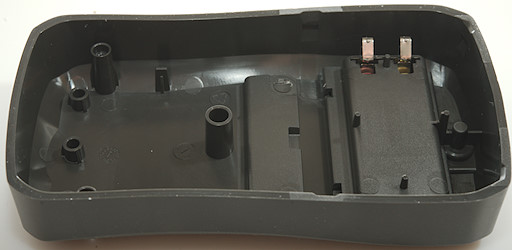
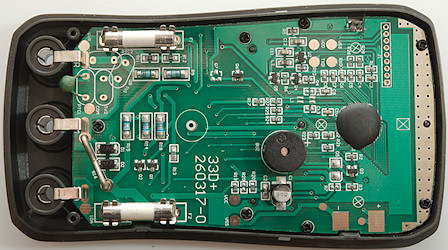
The circuit board fits nicely into the shape of the multimeter.
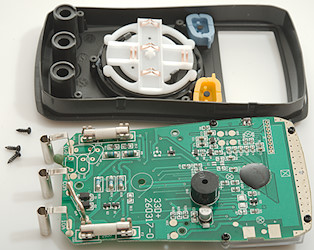
3 more screws and I could remove the circuit board from the front.
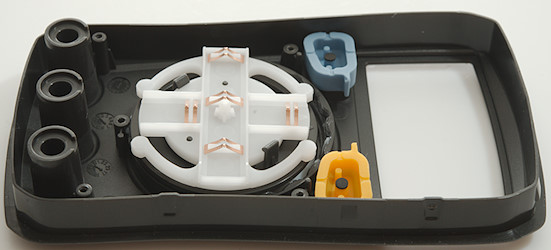
The range switch use plastic clicks, not steel balls (Some name brands do the same).
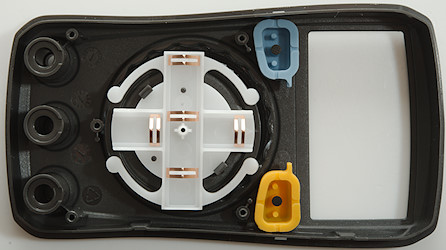

Looking at the voltage input there is one PTC and space for one more and also space for two MOV’s, the missing transistor Q7 is also part of the protection, maybe some EU versions of the DMM has this mounted.
The two MELF resistors after the protection (R8, R9: 2 × 5Mohm) is the input resistance. There is also another input chain (R11, R12: 2 × 499kOhm).
The current input uses the 3 resistors (R15: 1ohm, R14: 9ohm, R15: 90ohm) close to D1 & D2 that is protection of the resistors until the fuse blows. Q1 & Q2 is input protection, in the ohm range they are directly after the MOV.
The chip U2 (Marked WBPL) is some sort of booster to get the backlight led working at low battery voltage.
At the front of the DMM is the NCV detector antenna, it fills the full width on both sides of the circuit board.
There is no trimpot or EEPROM, this means the calibration must be inside the DMM chip, probably related to the RXD and TXD pads. There are also pads at the input terminals, this looks like it is designed for automatic calibration.

It took four screws more the removed the display. As usual a LCD display with a zebra stipe for connection. The backlight module was soldered to the circuit board (Only the led).
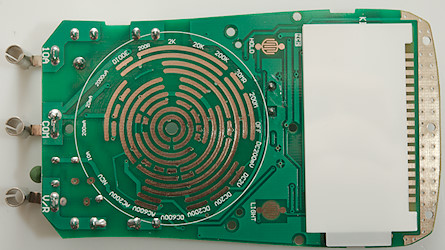
On this side is the range switch with nice markings and the two push buttons. At the top is the connection to the LCD display and the NCV antenna.
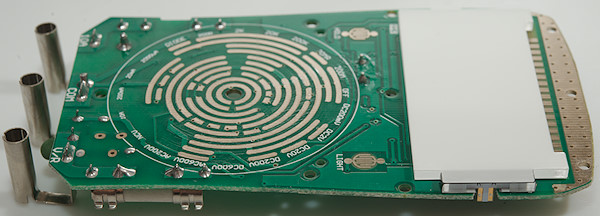
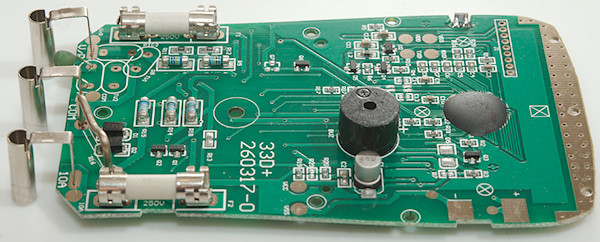
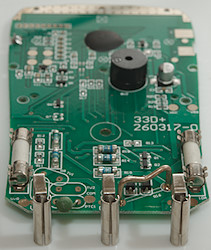
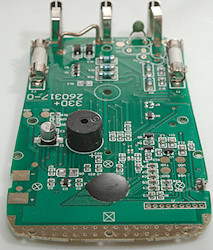
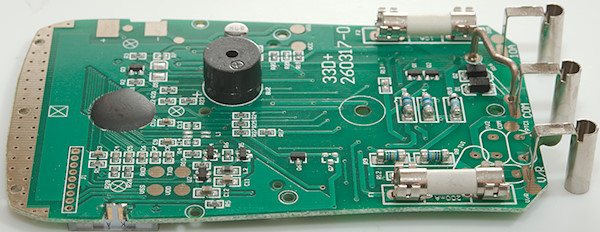
Conclusion
The CAT rating do not match the fuses used, i.e. it is not correct, but at least it use fuses and fairly good ones.
For a “simple” meter this is fairly well designed, AC/DC volts works properly and it has some input protection. It has good specifications and it looks like it stays within the specified tolerances.
I was a bit surprised that this meter is a true rms meter.
Notes
UNI-T do often make rebranded meters, i.e. it may exist with other names on it.
How do I review a DMM
More DMM reviews
My website with reviews of many chargers and batteries (More than 1000): http://lygte-info.dk/
 : Continuity and diode.
: Continuity and diode.